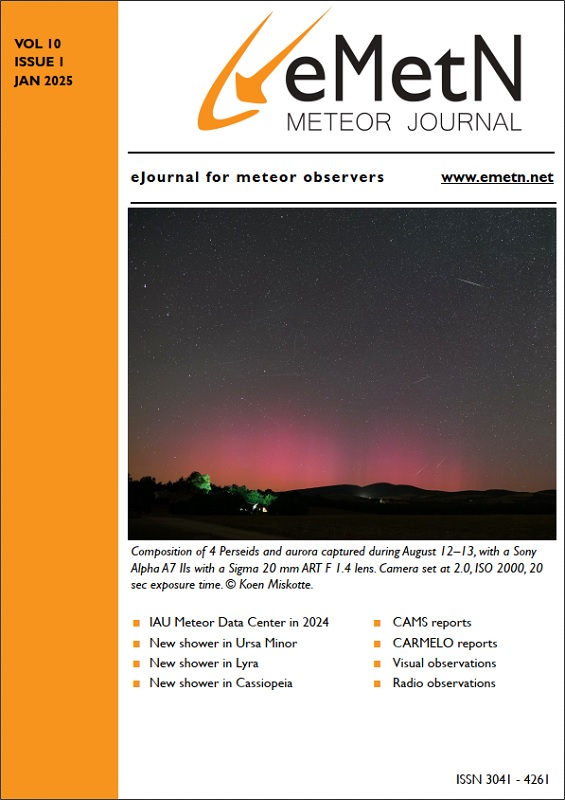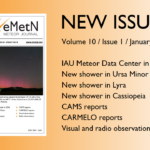During this period the moon reaches its full phase on Thursday August 15th. On that date the moon is located opposite the sun and lies above the horizon all night long. This weekend the waxing gibbous moon will set during the early morning hours, giving a small window of opportunity to view in dark skies while the moon is low in the west or below the horizon. The estimated total hourly meteor rates for evening observers this week is near 4 as seen from mid-northern latitudes (45N) and also 3 for those viewing from subtropical southern latitudes (25S). For morning observers the estimated total hourly rates should be near 28 as seen from mid-northern latitudes (45N) and also 21 for those viewing from subtropical southern latitudes (25S). The actual rates will also depend on factors such as personal light and motion perception, local weather conditions, alertness and experience in watching meteor activity. Evening rates are reduced due to moonlight. Note that the hourly rates listed below are estimates as viewed from dark sky sites away from urban light sources. Observers viewing from urban areas will see less activity as only the brighter meteors will be visible from such locations.
The radiant (the area of the sky where meteors appear to shoot from) positions and rates listed below are exact for Saturday night/Sunday morning August 10/11. These positions do not change greatly day to day so the listed coordinates may be used during this entire period. Most star atlases (available at science stores and planetariums) will provide maps with grid lines of the celestial coordinates so that you may find out exactly where these positions are located in the sky. A planisphere or computer planetarium program is also useful in showing the sky at any time of night on any date of the year. Activity from each radiant is best seen when it is positioned highest in the sky, either due north or south along the meridian, depending on your latitude. It must be remembered that meteor activity is rarely seen at the radiant position. Rather they shoot outwards from the radiant so it is best to center your field of view so that the radiant lies at the edge and not the center. Viewing there will allow you to easily trace the path of each meteor back to the radiant (if it is a shower member) or in another direction if it is a sporadic. Meteor activity is not seen from radiants that are located below the horizon. The positions below are listed in a west to east manner in order of right ascension (celestial longitude). The positions listed first are located further west therefore are accessible earlier in the night while those listed further down the list rise later in the night.
These sources of meteoric activity are expected to be active this week.
.
The August Draconids (AUD) were discovered by Zdenek Sekanina in his study of meteor streams using radio methods. This stream is active from August 13-19 with maximum activity occurring on the 16th. The radiant is currently located at 18:04 (271) +59, which places it in southern Draco, 8 degrees north of the 2nd magnitude star known as Eltanin (gamma Draconis). This radiant is best placed near 2200 Local Summer Time (LST), when it lies on the meridian and is located highest in the sky. With an entry velocity of 21 km/sec., the average August Draconid meteor would be of slow velocity. Rates this week are expected to be less than 1 per hour no matter your location. Due to the high northern declination these meteors are difficult to observe from the southern hemisphere.
The kappa Cygnids (KCG) are active from a radiant located near 18:56 (284) +49. This area of the sky lies in southeastern Draco, mid-way between the two bright stars known as Etanin (gamma Draconis and Fawaris (delta Cygni). This radiant is best laced near 2300 LST when it lies on the meridian and is located highest in the sky. With a high northern declination, these meteors are difficult to view from the southern hemisphere. Expected hourly rates this week are near 1 as seen from the northern hemisphere and less than 1 as seen from south of the equator. With an entry velocity of 21 km/sec., the average meteor from this source would be of slow velocity.
The last of the alpha Capricornids (CAP) are expected this weekend. The radiant is located at 21:05 (316) -07, which places it in western Aquarius, 6 degrees west of the 3rd magnitude star known as Sadalsuud (beta Aquarii). This radiant is best placed near 01:00 (LST), when it lies on the meridian and is located highest in the sky. Hourly rates at this time should be less than 1 no matter your location. With an entry velocity of 22 km/sec., the average alpha Cap meteor would be of slow velocity.
The center of the large Anthelion (ANT) radiant is currently located at 22:04 (331) -12. This position lies in southwestern Aquarius, 3 degrees north of the 4th magnitude star known as iota Aquarii. Due to the large size of this radiant, anthelion activity may also appear from eastern Capricornus as well as Aquarius. This radiant is best placed near 02:00 (LST), when it lies on the meridian and is located highest in the sky. Rates at this time should be near 1 per hour as seen from mid-northern latitudes (45 N) and 2 per hour as seen from the southern tropics (S 25). With an entry velocity of 30 km/sec., the average anthelion meteor would be of slow velocity.
The Northern delta Aquariids (NDA) are active from July 23 through August 27 with a peak expected near August 14. The radiant is currently located at 22:58 (344) +01. This position is located in western Pisces, near the spot occupied by the faint star known as 2 Piscium. This location is also 6 degrees east of the 4th magnitude star known as eta Aquarii. Hourly rates should be near 2 per hour no matter your location. The radiant is best placed near 03:00 LST, when it lies highest in the sky. With an entry velocity of 38 km/sec., these meteors would be of medium velocities. This shower seems to be a continuation of the Northern June Aquilids, which had been active since early June.
The Southern Delta Aquariids (SDA) are active from a radiant located at 23:27 (352) -12. This position is located in central Aquarius, 3 degrees southeast of the group of faint stars known as phi Aquarii. Maximum activity was expected on July 30th. Current hourly rates will range from 1 as seen from mid-northern latitudes (45N) and 4 as seen from the southern tropics (25S). The radiant rises near 22:00 LST for observers located in the southern tropics, but is best placed near 03:00 LST, when it lies highest in the sky. With an entry velocity of 41 km/sec., most activity from this radiant would be of average velocities.
The Piscids Austrinids (PAU) are an obscure shower, not well seen from the northern hemisphere. Recent studies by the IMO Video Network shows little activity. Other studies have indicated that this shower is active later than previously thought. We will go along with that idea until more information is available. It is now thought that this radiant is active from July 31 through August 19, with maximum activity occurring on the 9th. Using these parameters, the current position of the radiant would be 23:41 (355) -19. This area of the sky is located in southeastern Aquarius, near the spot occupied by the faint stars known as 103-108 Aquarii. The radiant is best placed near 04:00 LST, when it lies highest in the sky. Current hourly rates should be less than 1 for those north of the equator and near 1 per hour for observers in the southern hemisphere. With an entry velocity of 44km/sec., most activity from this radiant would be of average velocities.
The Perseids (PER) are active from a radiant located at 03:01 (045) +57. This position lies in northwestern Perseus, near the spot occupied by the faint star known as k Persei. 3 degrees to the southwest lies the brighter 4th magnitude star known as Miram (eta Persei). This area of the sky is best placed for viewing during the last dark hour before dawn when it lies highest in the sky. Maximum occurs on August 13 when late morning rates are expected to reach 20 per hour as seen from the northern hemisphere and 5 as seen from south of the equator. Activity from this source is visible all night long but moonlight greatly interferes with viewing the Perseids this year and activity will be reduced compared to other years. Early in this period observers should try viewing during the last few hours prior to dawn when the moon will be low in the west or below the horizon. Better activity will be seen in the darker sky. With an entry velocity of 59 km/sec., the average meteor from this source would be of swift velocity.
The eta Eridanids (ERI) were discovered by Japanese observers back in 2001. Activity from this stream is seen from July 23 through September 17 with maximum activity occurring on August 11. Many observers note this activity during the morning hours this time of year while viewing the far stronger Perseid shower. The radiant currently lies at 02:56 (044) -12 which places it in western Eridanus, 3 degrees south of the 4th magnitude star known as Azha (eta Eridanus). This area of the sky is best seen during the last dark hour before dawn when the radiant lies highest in a dark sky. Current rates are expected to be near 2 per hour during this period no matter your location. With an entry velocity of 65 km/sec., the average meteor from this source would be of swift velocity.
As seen from mid-northern hemisphere (45N), morning rates would be near 11 per hour as seen from rural observing sites and 3 per hour during the evening hours. As seen from the tropical southern latitudes (25S), one would expect to see approximately 7 sporadic meteors per hour during the last hour before dawn as seen from rural observing sites. Evening rates would be near 2 per hour. Locations between these two extremes would see activity between the listed figures. Evening rates are reduced during this period due to moonlight.
The list below offers the information from above in tabular form. Rates and positions are exact for Saturday night/Sunday morning except where noted in the shower descriptions.
| SHOWER | DATE OF MAXIMUM ACTIVITY | CELESTIAL POSITION | ENTRY VELOCITY | CULMINATION | HOURLY RATE | CLASS |
| RA (RA in Deg.) DEC | Km/Sec | Local Summer Time | North-South | |||
| August Draconids (AUD) | Aug 16 | 18:04 (271) +59 | 21 | 22:00 | <1 – <1 | IV |
| kappa Cygnids (KCG) | Aug 14 | 18:56 (284) +49 | 21 | 23:00 | 1 – <1 | II |
| alpha Capricornids (CAP) | Jul 27 | 21:05 (316) -07 | 22 | 01:00 | <1 – <1 | II |
| Anthelion (ANT) | – | 22:04 (331) -12 | 30 | 02:00 | 1 – 2 | II |
| Northern delta Aquariids (NDA) | Aug 14 | 22:58 (344) +01 | 38 | 03:00 | 2 – 2 | IV |
| Southern Delta Aquariids (SDA) | Jul 30 | 23:27 (352) -12 | 41 | 04:00 | 1 – 4 | I |
| Piscids Austrinids (PAU) | Aug 09 | 23:41 (355) -19 | 44 | 04:00 | <1 – 1 | II |
| eta Eridanids (ERI) | Aug 11 | 02:56 (044) -12 | 67 | 07:00 | 2 – 2 | IV |
| Perseids (PER) | Aug 13 | 03:01 (045) +57 | 59 | 07:00 | 10 – 3 | I |







